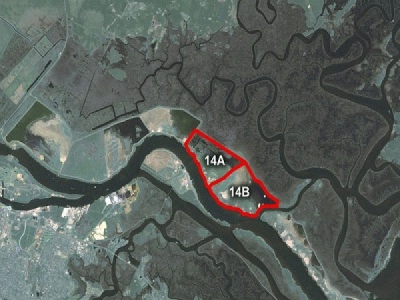
Posted on January 5, 2017
Two proposed changes to the placing of cadmium-laden dredged sediments at dredged material containment areas (DCMAs), as part of the Savannah Harbor Expansion Project, are available for review in a Draft Supplemental Environmental Assessment (SEA). This SEA supplements the July 2012 Final Environmental Impact Statement for the Savannah Harbor Expansion Project. Corps officials recommend placing material in a manner that reduces risks to wildlife without causing dike failure. Corps officials will accept written public comments on the proposed changes until 12 p.m. on Feb. 3, 2017.
The changes include refining the channel reaches that contain naturally-occurring cadmium at levels that require special handling and keeping deposited cadmium-laden sediments moist in DCMAs 14A and 14B by maintaining the water height in the DMCA just below the elevation of deposited dredged sediment, rather than flooded.
Officials would place approximately 4.4 million cubic yards (MCY) bulked of cadmium-laden sediments in DMCA 14A in a moist (inundated) but not flooded condition, with the effluent passing through DMCA 14B, if needed. It includes a reduction in the quantity of sediment (11.7 MCY to 4.4 MCY) that require special handling as cadmium-laden sediment; low level inundation during sediment placement, rather than placement in a flooded state; and mitigation (bird abatement) during placement of sediments in DMCAs 14A and 14B. The reduced volume of cadmium-laden sediments should allow for these sediments to be placed within one DMCA.
The cadmium-laden sediments would be kept moist in the DMCA by placing stop logs in the weirs to maintain the water height just below the height to which the dredged material is placed. This saturation level will limit the drying of the sediments, and thereby the mobility of the cadmium, while still allowing the sediments to be worked with equipment as it is placed. This approach would limit wildlife exposure to the deposited cadmium-laden sediments.
The cadmium-laden sediments would then be covered, or capped, with a clean two-foot layer of sediments. The requirements for the cover material and the required testing would not change.
Cadmium has been found to occur naturally in elevated levels within Miocene soils that would be excavated during the SHEP dredging. Evaluation of laboratory results indicated that adverse impacts to birds were likely from normal placement of sediments with elevated cadmium levels into the DMCAs. Corps officials will monitor impacts before, during and after the deepening.
The Draft SEA and Draft Finding of No Significant Impact can be found online. Copies may also be obtained through email request to the following address: CESAS-PD@usace.army.mil, or by contacting Mr. Nathan Dayan at (912) 652-5172.
Those wishing to comment on the proposed action should submit written comments to the U.S. Army Corps of Engineers, Savannah District, Planning Division, ATTN: Mr. Nathan Dayan (PD), 100 West Oglethorpe Avenue, Savannah, Georgia 31401-3640, by FAX to 912-652-5787, or by emailing the comments to CESAS-PD@usace.army.mil.
Source: US Army Corps of Engineers





